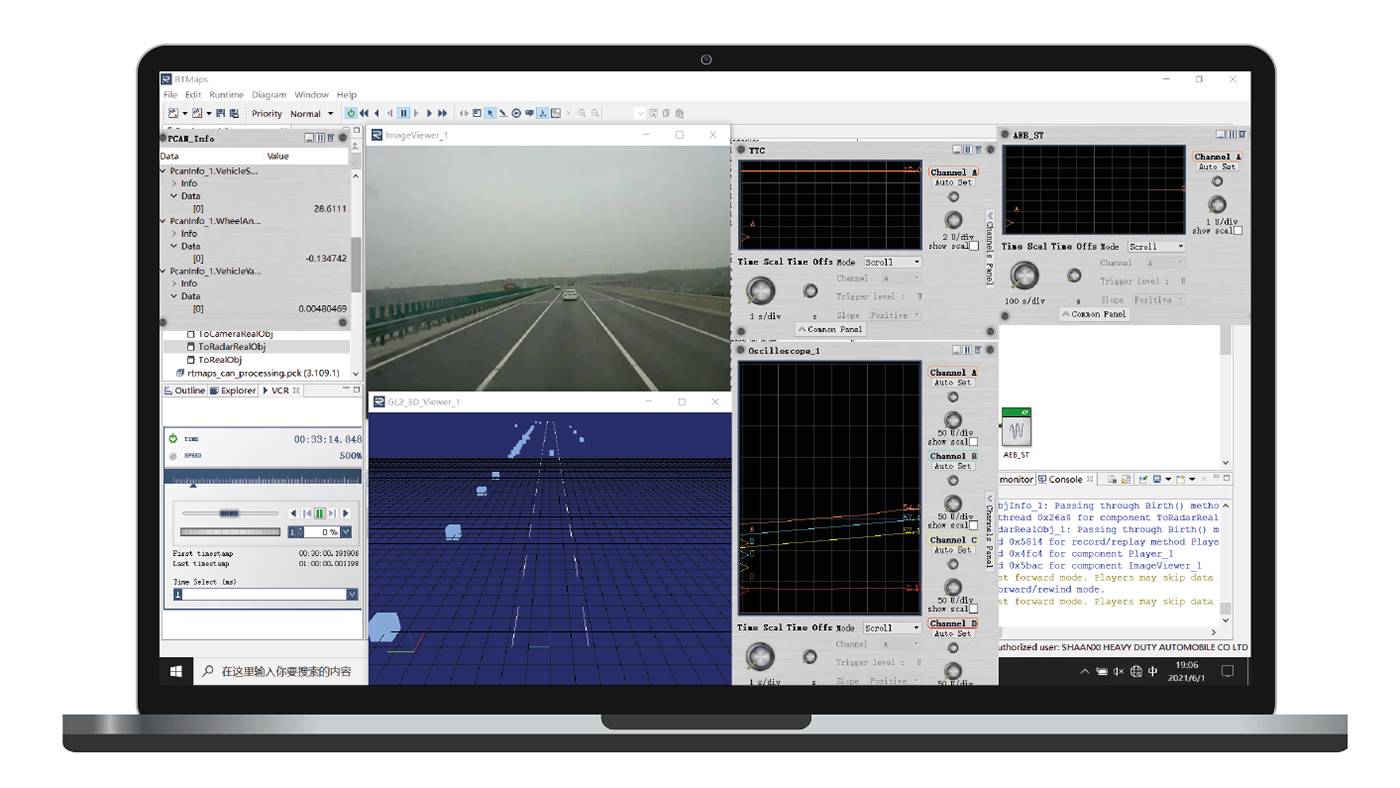Shaanxi Automobile Group Co., Ltd. is equipping its vehicle fleet with cameras, radars, and an advanced emergency braking system to give its customers the highest possible level of safety. To develop the software more efficiently, the company relies on RTMaps, a development and execution environment for multisensor applications from Intempora, a dSPACE company.

Whether in city centers or on rural roads, truck drivers always have to keep an eye on traffic, traffic lights, and road signs, while watching out for pedestrians and cyclists. But even the most attentive drivers struggle with the large blind spots and long braking distances of their commercial vehicles, which weigh several tons. Driver assistance systems provide vital support in reducing the number of traffic accidents and protecting drivers as well as other road users: They warn drivers if a collision is imminent. If the driver does not res- pond, the system automatically initiates emergency braking.

Reliable Algorithms for Vehicle Safety
Yiran Zhang, head of the electric control division explains, “Shaanxi Automobile Group aims to further strengthen its leading role İn the field of intelligent connected commercial vehicles in China. To this end, we are pushing ahead with the development of an advanced emergency braking system (AEBS). Our goal is to develop a safe and reliable AEBS algorithm characterized by a high correct-recognition rate and a low false-recognition rate. We will bring this algorithm into series production for our wide range of vehicles,” adds Yiran Zhang. The AEBS includes a control unit with intelligent cameras and millimeter-wave radars.
The Challenges of Multisensor Data
At the outset of the project, the developers used recorded CAN messages from the sensors to test the algorithm implemented on an ECU. This approach quickly reached its limits due to increasingly complex test data and a growing number of corner cases that had to be analyzed in detail. The developers then formulated requirements for a powerful test environment:
- Synchronous playback of all sensor data to ensure correct, time-correlated data fusion
- Synchronous visualization of the test scenarios with recorded motion images to quickly assess the output of the fusion and detection algorithms
- Easy localization of relevant test data in a large data pool
- Efficient handling of large amounts of data

Mastering Complexity
Shaanxi Automobile Group selected RTMaps, a development and execution environment for multisensor applications as it meets all of the above challenges. It was also found to be suitable to support the design and validation of advanced and complex software functions. Junjie Bai, responsible for the development of the perception algorithm reports, “When started working with RTMaps, it was a night and day difference compared to the initial approach. With RTMaps, we control extensive, complex sensor data that we can synchronize to develop and validate our specific algorithms.” First, the developers used RTMaps to synchronously record large volumes of sensor data during measurement runs. This includes the original video of the webcam, the audio signal of the microphone, the target lists of the intelligent camera, and the millimeter-wave radar in the form of CAN messages. The developers then integrated the AEBS algorithm in the RTMaps graphical development environment and put it into operation with the recorded data.
Efficient Workflows in RTMaps
”With RTMaps, we can quickly replay real sensor data, both raw data and CAN messages, and start replay from any point in time. This is particularly useful for developing the fusion and perception algorithms,” says Junjie Bai. The team reports an easy-to-use yet efficient workflow in RTMaps: The tool allows the selection of input signals for the AEBS algorithm – in this case, the original sensor messages captured on the CAN bus, and further sensor signals are key variables of the algorithm. The original video can be used in RTMaps to visualize and check the respective driving situation, while the audio signal reproduces the alarm signals in the vehicle. “Thus, the developer is always informed about all recorded aspects that occurred during a driving situation,” concludes Junjie Bai. Furthermore, parameters can be added to the algorithm to calibrate and optimize it. Particularly relevant sensor data, such as test cases for testing behavior in specific situations or so-called corner cases, can be extracted and is then available as validation data for subsequent algorithm optimization.
Advanced Emergency Braking System (AEBS)
The system warns the driver of an imminent collision with a slow-moving or stationary vehicle ahead. If necessary, it can also hit the brakes to prevent the collision or reduce the speed of impact.

Fast Evaluations of Sensors
For some of the commonly used sensor types, the performance of different sensor makes has to be compared before algorithm development begins. RTMaps lets developers evaluate and visualize the target lists of the sensors, allowing for an easy comparison and a quick selection of the most suitable sensor.

Support of Multiple Programming Methods
Developers often use multiple programming environments to write complex algorithms: for example, C/C++ to build the basic structure, Python for image processing, and Simulink® for the application layer. The open and flexible code development environment of RTMaps supports this multifaceted approach and allows developers to collaborate efficiently despite different programming methods.

Efficiency Gain in Development
At Shaanxi Automobile Group, three developers work with RTMaps. It took approximately three weeks to familiarize the team with the software’s main features, and now RTMaps plays a central role in the development and validation of perception and fusion algorithms. Yiran Zhang summarizes, “RTMaps is the core tool for the rapid, targeted development of AEBS. Offline validation of algorithms with real data helps quickly identify problems and develop solutions. This reduces development time, effort, and cuts costs. Using RTMaps improves the efficiency of algorithm development by more than 50%. This shortens the time to market.”
Safe Vehicles Ensure Customer Recognition
The algorithm developed and validated with RTMaps is intended for the Shacman X6000, X5000 vehicle platforms. In the next step, RTMaps will be used to develop the adaptive cruise control and adaptive speed control algorithms. This way, Shaanxi Automobile Group aims to meet the requirements of its customers, generate added value for them, and take on the leading role in the industry. The developers are certain: Reliable functions for automated driving will win their customers’ favor.
Courtesy of Shaanxi Automobile Group Co., Ltd.
dSPACE MAGAZINE, PUBLISHED NOVEMBER 2021
Shaanxi Automobile Group Co., Ltd.
With approximately 13,000 employees, Shaanxi Automobile Group Co., Ltd. is one of the larger employers in the People’s Republic of China. The company manufactures trucks. The manufacturer’s headquarters are located in Xi’an, Shaanxi.



